December 7, 2012
Air Date: December 7, 2012
FULL SHOW
SEGMENTS
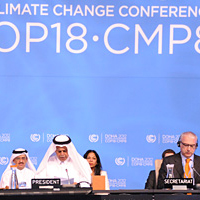
UN Climate Talks in Doha
View the page for this story
Delegates from more than 190 nations meet in Doha, Qatar to negotiate limits on climate-changing gas emissions and funding for developing countries for adaptation. Union of Concerned Scientists’ Alden Meyer tells host Steve Curwood about progress made at this year’s talks. (06:15)
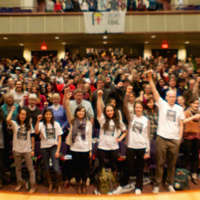
Moving for Divestment
/ Emmett FitzGeraldView the page for this story
Bill McKibben maybe the closest thing the environmental movement has to a rock star. In November he took to the road, urging colleges to pull their endowments out of fossil fuel stocks, to pressure the industry to address climate change. Living on Earth's Emmett FitzGerald reports from Brown University in Providence, Rhode Island. (05:25)
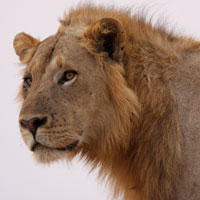
Trouble for the King of Beasts
View the page for this story
The lion is now more threatened than ever before. Lion populations have dropped sharply in the last fifty years, largely due to habitat loss and poaching. Host Steve Curwood talks with Stuart Pimm, co-author of a new lion habitat survey and Chair of Conservation Ecology at the Nicholas School of the Environment at Duke University in North Carolina. (07:20)
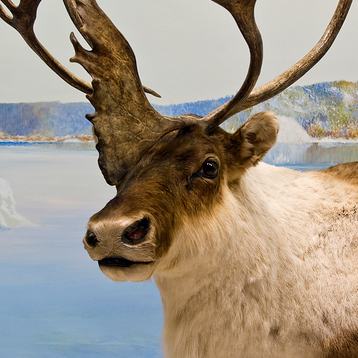
Reindeer Populations in Decline
View the page for this story
Reindeer, or caribou, are in dramatic decline in the far north. Jeff Flocken of the International Fund for Wildlife explains that changing weather makes food hard to obtain for some caribou. Also indigenous communities depend on the herds for food and as a cultural touchstone. George Rich, an elder of the Innu tribe in northern Canada, tells host Steve Curwood that he doubts his tribe can survive without a healthy caribou population. (09:00)
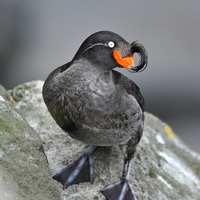
BirdNote ® Crested Auklet
/ Mary McCannView the page for this story
Mary McCann reports about the Crested Auklet, which makes its home in the frigid Bering Sea between Alaska and Siberia. (02:10)

Oil Dispersants and the Ecology of the Gulf
View the page for this story
During the 2010 Gulf Coast oil spill disaster, BP used a chemical called Corexit to disperse the slicks. According to a paper recently published in the journal Environmental Pollution, that decision may have increased the damage to the marine environment. Terry Snell, Chair of the School of Biology at the Georgia Institute of Technology, discusses his findings with host Steve Curwood. (08:05)

Predicting the End of the World
/ Bruce GellermanView the page for this story
The Mayan Long Count Calendar comes to the end of its 5125 year cycle this month. New age prophecies, based on the ancient calendar, warn the world will end when the cycle concludes. Living on Earth's Bruce Gellerman travels to the Mayan ruins of Chichen Itza to track down the truth. (09:00)
Show Credits and Funders
Show Transcript
HOST: Steve Curwood
GUESTS: Alden Meyer, Stuart Pimm, George Rich, Terry Snell
REPORTERS: Emmett FitzGerald, Mary McCann
[THEME]
CURWOOD: From Public Radio International, this is Living on Earth. I'm Steve Curwood. The climate summit wraps up in Doha. One sticking point: Who will pay to help the developing world adapt to climate change?
MEYER: When the world banking system was on the verge of collapse leaders and finance ministers from around the world mobilized one trillion dollars to bail out the banks and yet we're having such a hard time going above 10 billion dollars a year to bail out the world's ecosystems and human communities.
CURWOOD: And vulnerable island nations are fast disappearing beneath the rising seas; and also disappearing, Africa's once boundless grasslands and their wildlife.
PIMM: Savannah Africa is in deep trouble, and it’s in fact in worse trouble than the world’s rainforests. And it’s those savannahs that lions depend upon and so lions are in trouble.
CURWOOD: That and more this week, on Living on Earth. Stick Around!
[THEME]
ANNOUNCER: Support for Living on Earth comes from Stonyfield Farm.
UN Climate Talks in Doha
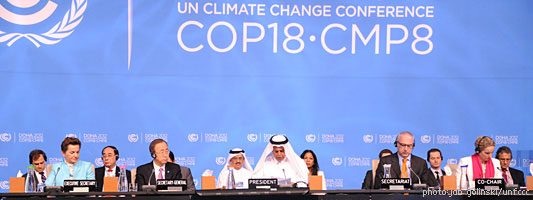
Delegates at the UNFCCC climate talks in Doha, Qatar. (UNFCCC)
CURWOOD: From the Jennifer and Ted Stanley Studios in Boston, this is Living on Earth. I'm Steve Curwood. For the last 18 years the United Nations Climate Secretariat has brought together just about all the nations for annual talks. But so far a rigorous deal for mandatory caps on global warming gases has stayed out of reach. There was Kyoto in 1997, where the US signed but later refused to ratify.
There was Copenhagen in 2009; that blew up when the world’s two biggest emitters, the United States and China collided amid hardball politics. Yet the process continues with weak agreements keeping it alive. This year the talks are in Doha, Qatar, where we turn to Alden Meyer of the Union of Concerned Scientists for an update.
MEYER: Well, this is a kind of a transitional meeting. It’s closing down two sets of negotiations that have been going on for about seven years ago, one extending the Kyoto protocol, giving it eight more years of life. And the other trying to engage the United States, developing countries and others that aren’t included in Kyoto in ramping up their level of ambition and action on climate change in a voluntary way outside of the legally binding framework. This meeting in itself in Doha is not going to lead to any more reduction in emissions that the atmosphere sees, it’s really more of a process.
CURWOOD: So, what does Doha mean for the Kyoto protocol?
MEYER: The initial comitments under the Kyoto protocol are due to end at the end of this month, in 2012, and since 2005, they’ve been negotiating about what would replace those or extend those. The betting here is that you would get the European Union, Australia, Norway, Switzerland, a few other countries, agreeing to stay in Kyoto, but you’ve already seen Japan, Russia, New Zealand and Canada say that they will not take on commitments covered by Kyoto. So the share of emissions covered by Kyoto continues to shrink. So, obviously by itself it’s not going to do the job.
CURWOOD: Now, the United States, indeed the world, is part of a voluntary deal cut in Copenhagen to reduce emissions. What’s been done about the voluntary side of things at the Doha meeting?
MEYER: Well, a couple of things. There have been a couple of countries that have come in and made pledges, the Dominican Republic, for example just announced that they would seek to cut their emissions by about 25 percent. The irony is that the host country, Qatar, which is one of the richest and highest emitting per capita countries in the world, has not made any pledges to reduce its emissions.
CURWOOD: What has happened in Doha in terms of getting legally binding limits on greenhouse gasses going forward?
MEYER: That part of the negotiation is actually going pretty well. In terms of laying out the plan of work for next year, for what’s called the Durban platform track. What’s not going well is finance. You’ll remember that in Copenhagen, President Obama and Hillary Clinton came in and promised to try to ratchet up collective support from developed countries on climate finance for activities like deploying renewable energy and energy efficiency technologies in developing countries, conserving rainforests and adapting to the mounting impacts of climate change.
They’ve committed to try to ramp up that support from the nearly ten billion dollars a year that has been financed a year, towards 100 billion a year toward 2020. And the big question here is: Will the United States, Japan, Europe and the other industrialized countries keep their promise?
CURWOOD: Of course the world is in the middle of an economic crisis…Alden Meyer, what are the odds of the industrialized countries keeping up this commitment to less developed countries to come up with all this cash for less developed countries to help fight climate change?
MEYER: Well, it’s obviously a tough fiscal environment in Japan, Europe and the US, but on the other hand, just think that Superstorm Sandy cost New Jersey, Connecticut and New York an estimated eighty billion dollars for one storm alone and that cost is rising. So, you have to put this into perspective of the impacts that we’re seeing. There was a very emotional intervention by the Philippines’ delegation talking about the impact of a typhoon that’s currently devastating the Philippines and what that’s doing, and it got a very emotional sustained ovation from everyone.
So I think people are putting this in perspective, and saying that yes, there is going to be a cost of helping developing countries take action, but the cost of inaction is far greater. And it’s also not gone unnoticed that when the world banking system was on the verge of collapse in 2008, leaders and finance ministers from around the world mobilized one trillion dollars, seemingly overnight, to bail out the banks. And yet, we’re having such a hard time going above ten billion dollars a year towards bailing out the world’s ecosystems and ailing communities.
CURWOOD: So, in the wake of extreme events like the typhoon in the Philippines and Hurricane Sandy in the greater New York area, what sense if any is there of renewed urgency in Doha to take more immediate action?
MEYER: Well, there’s clearly continuing urgency among the countries on the front lines: the least developed countries, the coastal countries, the small island states like Bangladesh, they’re getting increasingly desperate in their pleas for help on this front. There doesn’t seem to be tremendous urgency among the major emitting countries whether it’s the US, Japan, China. I think the reality is that until those countries and political leaders start feeling some political heat from their constituencies back home that that’s not likely to change.
CURWOOD: Alden, before, you go, observers of this process see it moving so slowly they question whether it serves any function anymore. How do you respond to folks that feel what’s going on at the UN Climate Summits isn’t amounting to much?
MEYER: Well, I mean, it’s not amounting to what we need, but it’s clearly doing more than we would have seen on the business as usual basis. So it is making a difference, it’s just not making enough of a difference fast enough. But the reality is, there’s no other game in town. You sort of have to negotiate and try to work your way through this by the system that you have, not the system that you wish you had.
CURWOOD: Alden Meyer is Director of Policy and Strategy at the Union of Concerned Scientists - thank you so much.
MEYER: Thanks Steve, great to be with you.
Related links:
- UNFCCC
- Alden Meyer if Union of Concerned Scientists
Moving for Divestment
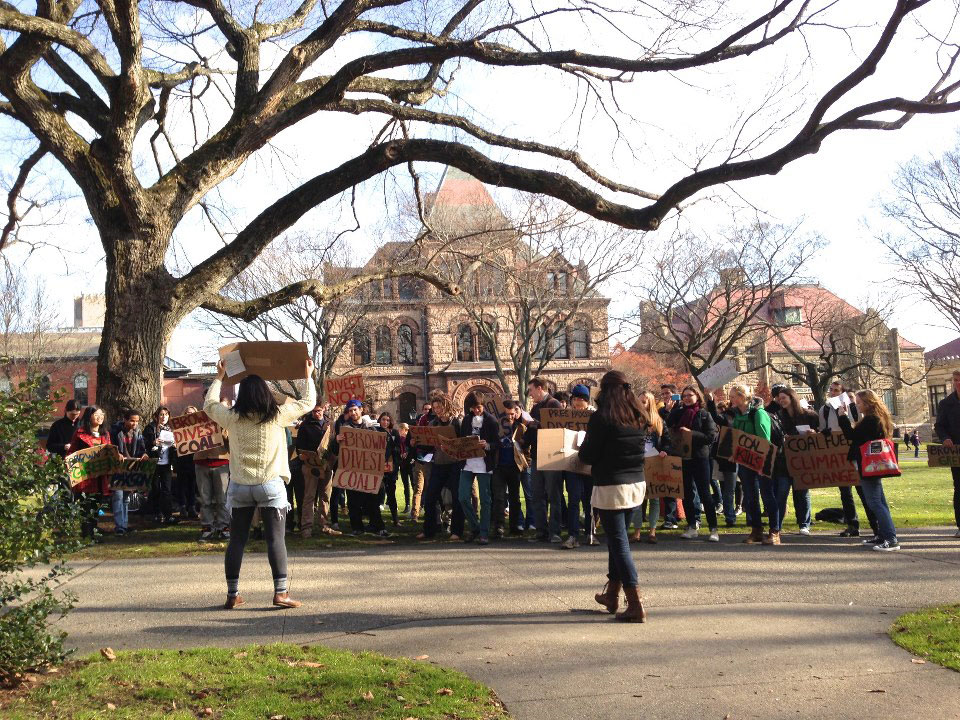
Student activists rally on Brown’s campus (photo: Brown Divest Coal Campaign)
CURWOOD: Analysts at the Carbon Tracker Initiative in London calculate that the fossil fuel industry has about 28 hundred gigatons of reserves of oil and gas in the ground.
Trouble is, that’s five times the amount that humanity can burn if we want to keep the global temperature rise below 3.6 degrees Fahrenheit, the target set by the voluntary 2009 Copenhagen accord.
Writer Bill McKibben of 350.org highlighted that math in a story he recently wrote for Rolling Stone magazine, and now he's on the road with what he calls the Do the Math Tour, playing to sold-out crowds from Atlanta to Seattle. Living on Earth’s Emmett FitzGerald has our story from Brown University in Rhode Island.
[CROWD CHEERS]
FITZGERALD: Brown University’s largest auditorim was filled to capacity when Bill McKibben took the stage.
[MORE CHEERS]
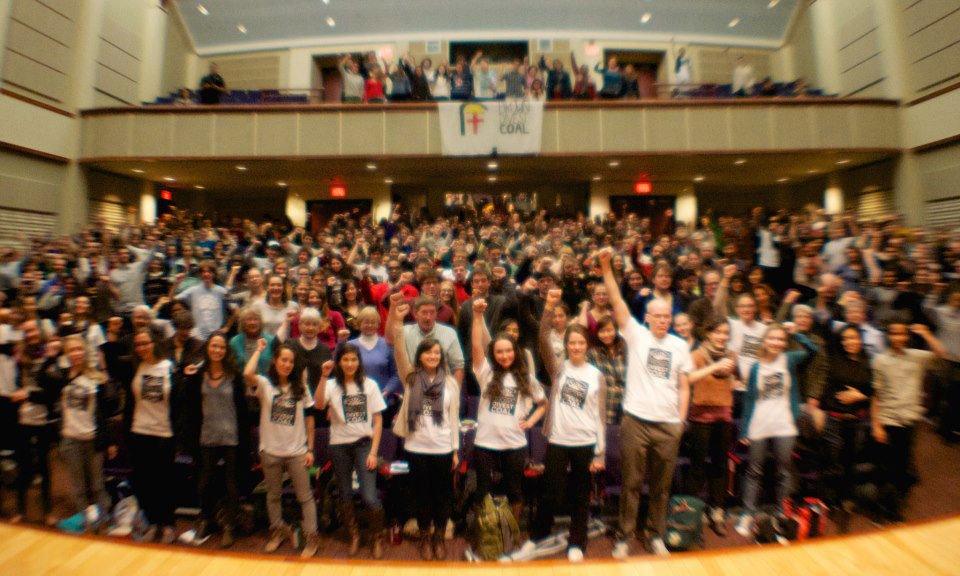
Bill McKibben and the Do the Math Tour at Brown University (Photo 350.org)
FITZGERALD: He wore old tennis shoes and a plain blue buttoned down shirt, the kind of clothes you might expect on a writer from Vermont. McKibben finds it a little funny that his Rolling Stone article went viral.
MCKIBBEN: It was in the issue with Justin Bieber on the cover, but two days later the editor called up and said ‘this is odd, your piece has ten times as many likes on Facebook as Justin Bieber’s’.
FITZGERALD: And Brown University liked him too. This was no ordinary Math lecture, environmentalists from Van Jones to Naomi Klein to the head of Greenpeace all made video appearances. And a group of students piled cases of beer onstage. McKibben compared the effects of binge drinking…
MCKIBBEN: They would be wasted, they would be polluted, they’d be smashed, they’d be trashed…
FITZGERALD: …With carbon pollution; a hangover lasts a few hours, carbon emissions, he said, last for geologic time. And he wasn’t only pushing the problem, he offered a way forward. On screen, Archbishop Desmond Tutu, a veteran of the anti-apartheid struggle in South Africa, spoke about how divestment campaigns run by U.S. college students helped to free his country from apartheid.
TUTU: The divestment movement played a key role in helping liberate South Africa. Climate change is a deeply moral issue too, of course. Once again, we can join together with the world and put pressure where it counts.
FITZGERALD: That’s Desmond Tutu, and for Bill McKibben, the only way to stop global warming is to attack the coal industry where it hurts, in the pocket book. He says that universities, with huge endowments invested in the stock market, have a key role to play.
MCKIBBEN: Colleges and churches and other places are where we think about moral issues. Colleges are where we learned about global warming, where the work was done, and if you go to any webpage of any university in America, there’s a long section outlining their commitment to sustainability—they’re greening the campus with new buildings, with bike paths, whatever it is. Well that’s good. We should be greening campuses, and if we are, then there’s no logical reason we’re not greening our portfolios at the same time.
FITZGERALD: In the months since the Do the Math tour hit the road, students at over 100 colleges have launched divestment campaigns. Tiny Unity College in Maine joined Hampshire College as the only schools to commit to divest entirely from the fossil fuel industry so far. The Brown Divest Coal Campaign was established this fall, and has been pressuring the administration to divest from what it calls the "filthy fifteen."
KIRKLAND: The filthy fifteen are basically the worst of the worst.
FITZGERALD: Emily Kirkland is a leader in the Brown Divest Coal Campaign.
KIRKLAND: They are coal mining companies or electric utilities that depend heavily on coal, and they are remarkable for their disregard for human health and the environment. Divesting from coal is something that Brown can do now. Coal is the largest global source of carbon dioxide emissions, and by divesting from coal, Brown can be a climate leader, starting right now.
FITZGERALD: The campaign organized a rally and gathered over 2,000 signatures on a petition in just a month. The student activists hope that the administration will take their demands seriously.
KIRKLAND: We’ve met twice with President Paxon. We’ve presented to a University committee dedicated to overseeing the social responsibility of the endowment. And we’re very optimistic that Brown’s administration will move quickly and make Brown one of the first schools in the country to divest.
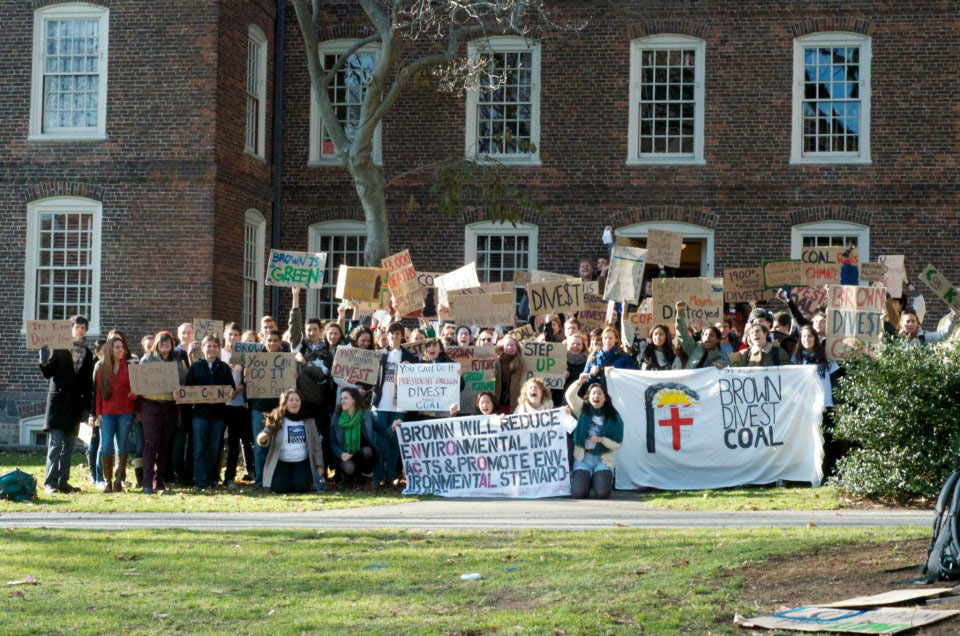
Brown Divest Coal Campaign rallies on campus (photo: the Brown Divest Coal Campaign)
FITZGERALD: As for Bill McKibben, he says that while the tour has been exciting, the road life of a rock star is wearing.
MCKIBBEN: Truth be told, the traveling around in the tour bus is somewhat more romantic in theory than in practice, and I’m a little worn out. The main problem is I’m 6 foot 3, and the bunks that we’re living in are 6 feet. So… but here we are in this biodeisel bus powering down the highway and it is a beautiful, beautiful country. And to wake up every morning rolling down the mountains in a different part of the country is a very beautiful thing.
FITZGERALD: He may be ready for a quiet winter in Vermont, but on this tour, he’s shown that he can bring the crowds to their feet.
[APPLAUSE]
MCKIBBEN: Stay on your feet and look around at each other, because you are what a group looks like. It makes no difference if you talk about this stuff, it makes enormous difference if you do something about this stuff!
[APPLAUSE, CHEERS]
FITZGERALD: For Living on Earth, I’m Emmett FitzGerald in Providence, Rhode Island.
Related links:
- Do the Math Campaign
- More about the coal divestment movement at Brown University
- More about Bill McKibben
[MUSIC: Donald Fagan “New Frontier” from Nightfly (Warner Bros. 1982).]
CURWOOD: Just ahead – counting big cats - and caribou. Stay tuned to Living on Earth!
[CUTAWAY MUSIC: Dave Brubeck: “The Duke” from Time Signatures: A Career Retrospective (Columbia Records 1992). (R.I.P. 12/06/1920 – 12/05/2012).]
Trouble for the King of Beasts

Lions are now more threatened than ever before. (Photo: Stuart Pimm)
CURWOOD: It’s Living on Earth, I'm Steve Curwood. Secretary of State Hillary Clinton declared December 4th 2012 the first ever “Wildlife Conservation Day,” an occasion to think about and try to act to preserve the fast disappearing wild creatures around the world. Consider the lion. He may be the king of the beasts, but he's not escaping the onslaught. A new study has found that Africa's lions are more endangered than ever before. Here to talk with us is one of the study authors, Stuart Pimm. He is the Chair of Conservation Ecology at the Nicholas School of the Environment at Duke.
PIMM: I think the expectation is that savannah Africa is a large wilderness with lions chasing after zebras. The reality that comes out of our study is that from an area about a third larger than the continental United States only about 25 percent remains. Savannah Africa is in deep trouble and it’s in worse trouble in fact, than the world’s rainforests. And it’s those savannahs that lions depend upon, and so lions are in trouble. They’ve lost three quarters of their habitat and done so probably in the last 50 years.
CURWOOD: You said a huge amount of the savannah has disappeared, what’s happened to it?
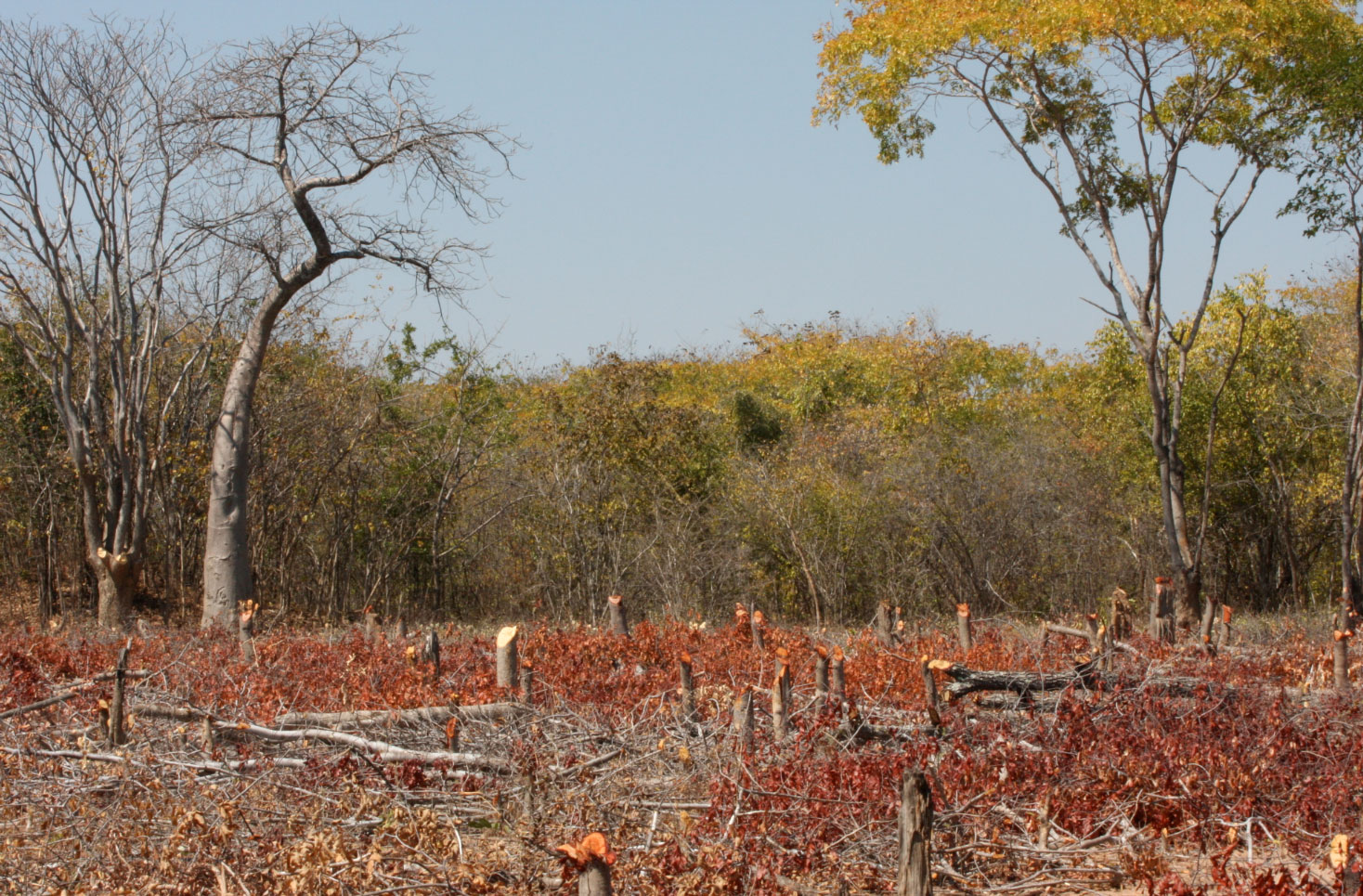
African woodlands being cleared. (Photo: Stuart Pimm)
PIMM: We were able to take a really close look, a very detailed look at savannah Africa by using Google Earth. We were able, as it were, to fly over the savannahs of Africa as if we were in a small plane at a low elevation. We were able to identify which areas had been converted to human use. And large areas of west Africa were thought to be sort of OK, and when we take a really close look, we realize that most of that area was already converted to small scale croplands.
CURWOOD: So, how many lions are we talking about? 50 years ago with four times as much territory as there is today… how many lions were there and how many lions are there today?
PIMM: We’re not totally sure of the estimates, but it seems that about 100,000 lions were roaming around 50 years ago… we’re now down to between 32 and 35 thousand.
CURWOOD: Now, which countries have lost their lions?
PIMM: Well, West Africa in particular is in bad shape. Almost no lions remain there. There was still strongholds of lions from South Africa through Botswana, Namibia, Tanzania, Kenya, but that’s a small fraction of the range of the lion.
CURWOOD: Now, what about the pastoralists? The people who live in the countryside and have livestock, and, well, there tends to be conflict sometimes with lions.
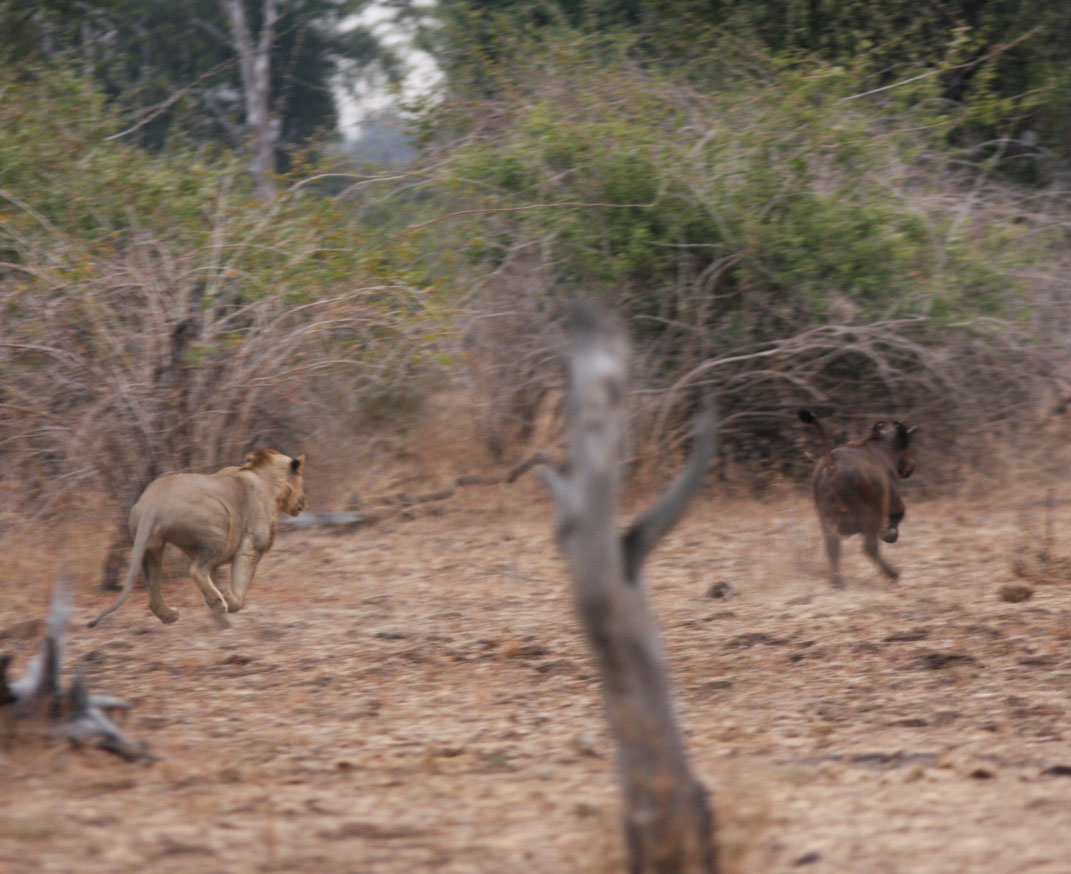
Lion hunting a buffalo. (Photo: Stuart Pimm)
PIMM: Except in South Africa, the national parks are not fenced. And indeed, they can’t be fenced because of the fact that lions need huge areas, larger than the national parks themselves. A particularly good example of this is the work done by Dr. Laly Lichtenfeld who works out in Tanzania. She works in a community outside a national park. During the wet season the animals move out over an area four times the size of the national park and that’s where they have conflicts with people.
Herdsmen bring their cattle and goats into protected areas, protected corrals, we call them bomas. These bomas are rings of thorny bushes, and lions are smart and they get through the bomas and kill the cattle. And so in the morning, the villagers are appropriately irate, find the lions and kill them. So, what Laly and her team are doing is to build better bomas. She’s using chainlink fence, she’s planting thorny bushes interweaved into the chainlink fence.
These bomas that she produces are lion-proof. And if the lions can’t get in, they’re not going to kill cattle. You know, the people are quite happy for lions to be wandering around, as long as they’re not killing their cattle. So, there are ways, created ways, of minimizing the conflict between lions and people, and I think the really exciting story that’s happening across Africa is that people are developing that technique and other techniques to minimize that conflict.
CURWOOD: What do you think is the impact of sport hunting on lions today?
PIMM: Ah, that is a difficult and very controversial question. Kenya bans all hunting, while Tanzania allocates more of its land to hunting than it does to national parks. So, two countries with big wildlife populations are taking very different strategies, and it reflects the great uncertainties in what’s the best way to manage lions.
Hunters would argue that they bring in a substantial amount of revenue from their hunts, and that revenue encourages Tanzania to allocate large areas for lion hunting and therefore protecting the lions. Kenya thinks that having lion hunts is a bad thing. The problem for which we do not have a good answer, is certainly if lion hunting is sustainable, then it protects large areas of countryside. We don’t know if it’s sustainable or not. And the evidence points to the fact is that in some places, lion hunting has caused lions to decline.
CURWOOD: What about poaching?
PIMM: It’s hard to say. I mean, poachers don’t check in and let you know how many animals they’re killing. There’s a lot of money to be made from it. Lion body parts are being exported as the nearest, best thing to tiger parts, which is the cause of tigers being hunted nearly to extinction. But it’s a major worry, clearly it’s a major worry for other African animals such as rhinos and elephants.
CURWOOD: African wildlife is under attack, it would seem… a decline in lions, a loss of elephants, rhinos, many other creatures. In your view what’s going on and what needs to be done in order to reverse the trend?
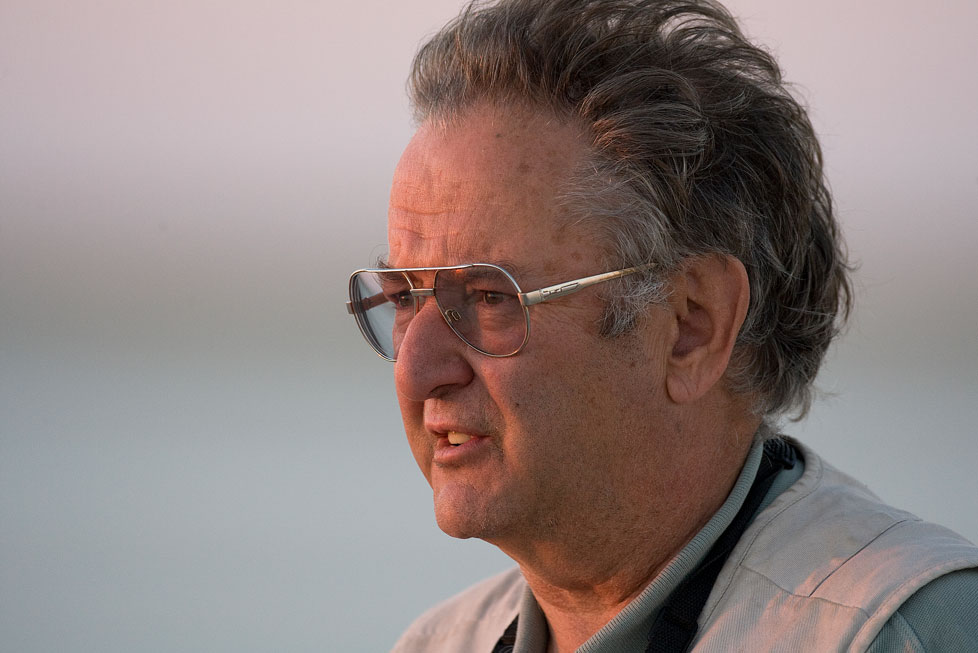
Stuart Pimm. (Photo: Rudi van Aarde)
PIMM: Well, African wildlife is under considerable threat. And even if one never is lucky enough to go to Africa, I think we all value a world in which, as Dorothy puts it in Wizard of Oz, ‘lions and tigers and bears, oh my!’ We’ve got national parks, but we’ve got to work out these solutions of allowing wildlife to roam over much larger areas than the national parks. So, that’s the solution, it’s not an easy one, it’s one where we have to bring in the people in the local communities as our partners and work out what the best local solution is.
CURWOOD: Stuart Pimm is the Chair of Conservation and Ecology at the Nicols School of the Environment at Duke University. Thank you so much Professor Pimm.
PIMM: Thank you for inviting me onto your program.
Related links:
- Africa’s lion habitat study by Stuart Pimm, Jason Riggio, et al
- More about Stuart Pimm
- Secretary of State Hillary Clinton announces December 4th Wildlife Conservation Day
Reindeer Populations in Decline
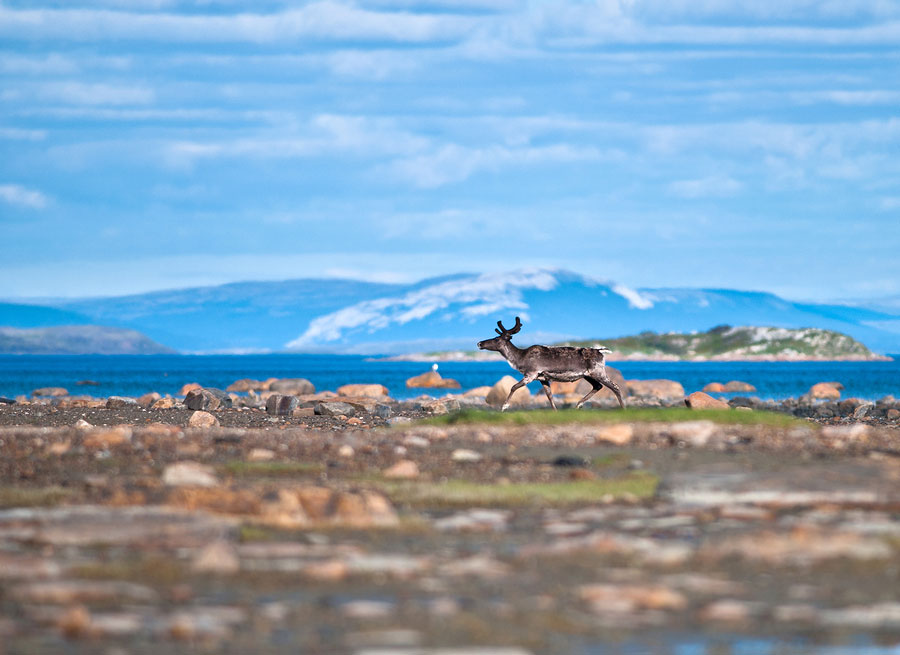
A reindeer near the Arctic Sea. (Bigstockphoto.com)
CURWOOD: From Africa we turn now to the Arctic where iconic creatures are also under assault, including a favorite of this holiday season, the reindeer. This time last year, we reported on serious declines in the populations of reindeer or caribou - on Victoria Island in Nunavut, Canada, where the Peary and the Dolphin-Union herds live. Jeff Flocken, the head of US Policy for the International Fund for Animal Welfare, said he was worried about them.
FLOCKEN: They’re in serious trouble. Well, caribou across the world, they’re all found in the northern hemisphere in these cold temperatures, are declining. They think an average decline of about 60 percent from historic highs. And these in the most northern part are even in more trouble. During the last few winters, they’ve found mass die-offs of the Peary ones in particular. Up to 84 percent of the population they think to have been lost.
CURWOOD: And Flocken said he knew what was wrong.
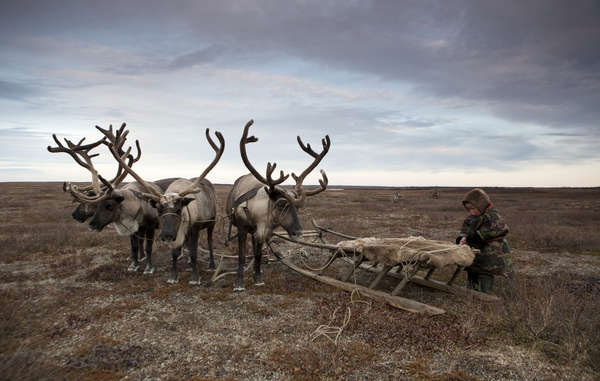
Tribes all around the world, such as Russia’s Nenets, depend on reindeer for their survival. (Photo: © Steve Morgan)
FLOCKEN: It’s climate change. The temperature, the weather and the landscape are all changing in the arctic. So, in particular, with this species - they’re a browsing species - and they need to have access to the different plants and native shrubs that grow in the tundra where they are in the winter. So usually, in past times, there’s kind of a light, fluffy snow that falls in that region, but now, because of the temperature change, they tend of have a heavy, icy rain.
So what’s happening is, it’s freezing over these plants so the reindeer can’t access them for food. What’s happening - they’re starving or they’re spending too much energy trying to find food. As a result - starvation, malnutrition, low-reproductive rates, and that’s causing these die-offs.
CURWOOD: Now, one solution, said Jeff Flocken, would be for the US Fish and Wildlife Service to list these two herds of caribou under the Endangered Species Act.
Well, the Service announced last spring that listing "may be warranted" but no further decision has been reached.
But those aren't the only Canadian caribou that are in decline - the George River herd further east in Labrador is also in trouble, and that's affecting native people who rely on the herds for meat and clothing. A population once estimated to be up to 900,000 reindeer has now been reduced to less than 28,000, and changing seasons are implicated in this decline as well. George Rich is an elder of the Innu tribe. He lives in a community of just 850 people in an indigenous village 150 miles north of Goosebay, Labrador.
RICH: Living in the same environment as the caribou, you notice that the caribou has a lot of problems with black flies in northern Labrador. Climate change which created the early thaw and early spring. Caribou rely on cold weather in the month of June, to able to bear calves. Apparently once everything is nice and warm, black flies will come. And it’s also attractive to the mineral exploration. Once the snow is gone it’s more attractive to the mineral exploration once it’s going on, you know?
CURWOOD: What happens in terms of the mineral exploration? What are they doing?
RICH: Well, ever since the big giant nickel find in 1993, in our territory, it’s been like a tornado of mineral explorations going on.
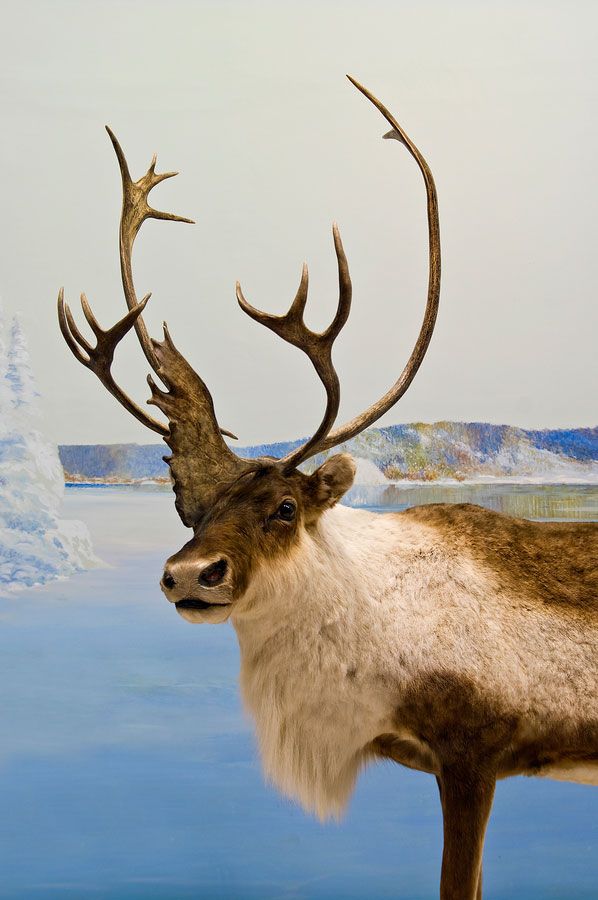
Close up of a caribou. (Bigstockphoto.com)
CURWOOD: Why is the mining so bad for the caribou, in your view?
RICH: In order to get the mineral exploration, you have to have choppers to go from one place to another. And the sound of the choppers really is a devastating sound because they don’t know where to look, all these choppers are going flying all over the place.
CURWOOD: So, it spooks them.
RICH: Yeah, it doesn’t pass in our migration route -- because our ancestors and our grandfathers and parents waited for many years. They’re having a different migration route. What’s happening right now, one of the mineral exploration companies is trying to build a road right in the heart of our territory. Right in the heart of calving grounds.
CURWOOD: So, what are you seeing now, have you noticed a difference in the caribou populations?
RICH: Yes, they’ve gradually decreased the last four or five years. We noticed when we went to our hunting grounds, we noticed that there are hardly any caribou -- only one or two showed up. The decline itself has been kind of devastating to the Innu.
CURWOOD: How do the caribou fit into your traditional way of life?
RICH: Well, we always rely on the caribou, we always depend on the caribou. Our ancestors, our grandparents and parents even, rely on the caribou for their clothing, their diet. It really is a traditional part and a spiritual aspect of our Innu way of life. A lot of ledgends and stories about the caribou.
CURWOOD: What’s your favorite story about the caribou?
RICH: There’s a story about a young man who had a dream about the caribou, wants to marry him. And he turned down the marriage in his dream. The spirit of the caribou who happened to be woman, said, ‘if you don’t obey me, you’re not going to be able to make it your campsite, your father’s campsite.’ He finally agreed to marry the spirit of the caribou that was in the dream.
He married and he went hunting and he left his bow and arrows in the mountain. And his father was very anxious and his brothers were very anxious looking for him everywhere and his footprints were leading towards the caribou herd. Then after that he wasn’t seen at all. The man who married the caribou was living among the caribou just like a human being. As always with the stories that we are told that the caribous are human beings, and this one shows I think that there’s a lot of respect in our culture.
CURWOOD: You sent us a recording of a caribou hunting song that I want to play now:
[MUSIC: CARIBOU HUNTING SONG]
RICH: The elder that was sharing this song that was passed on by his brother to him, and this song was probably passed on for many generations. It’s a kind of a hunting song, you are so far away, I cannot reach you, I’ll catch up with you and call my friends… in that song.
CURWOOD: Tell me about your culture, what particularly do you do with caribou for rituals among the Innu.
RICH: Well, the main source of things that we do with the caribou once hunting is successful, all the hunters will gather the caribou hindlegs, clean the meat then pound the caribou bones and to what we call the mukushan, which is a feast, for all of the people to attend. I don’t know if you’re familiar with the Catholic church when the priest will hold comunion and give the holy bread to the people -- that’s the kind of sacred thing we do with the caribou.
CURWOOD: How has the scarcity of the caribou herd affected your people and your culture?
RICH: Innu people used to follow caribou all along, a lot of exercise. We used to store maybe one or two caribou in the freezer…
CURWOOD: What do you eat these days, if not caribou?
RICH: We are forced to eat the store-bought food. We live in a very isolated community. Labrador…the only access to that is through by plane and by coastal freighter in the summer time. And when most of the frozen food comes in there, it’s not in a very good situation at all. And then that’s created a lot of problem in diet and eating junk food. And all that has created the problems… a diabetes epidemic is one of the things that we are facing right now.
CURWOOD: A lot of diabetes, you say?
RICH: 30 percent of people in my communities have diabetes. A lot more with the kidney failures.
CURWOOD: How will your community be affected if the caribou disappear from your region altogether?
RICH: Without the caribou, I don’t think that the Innu will be able to survive as the Innu themselves because the caribou is our identity, it’s our culture, it’s our way of life, it’s also a part of the big spiritual awareness of what’s going on in the animal world. And without the caribou we don’t think the Innu will be able to survive.
CURWOOD: I do hope the caribou come back soon.
RICH: Well, I certainly hope so. I certainly hope so.
CURWOOD: George Rich is an elder of the Innu tribe in northern Canada at Labrador. Thank you so much, sir.
RICH: Thank you very much.
Related links:
- More about the Innu
- Innu Stories From the Land
- Survival International
[BIRDNOTE® THEME]
BirdNote ® Crested Auklet
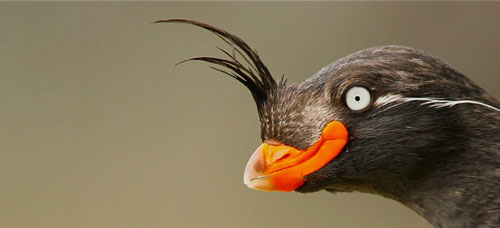
Crested Auklet, up close! (Photo: © Paul Jones)
CURWOOD: We stay up in the far north, in an equally cold part of the globe - for BirdNote today - but travel over to the other side of the North American continent. Here's Mary McCann.
MCCANN: The Bering Sea in winter is a realm to which most people – aside from some very hardy fishermen – give a wide berth. Winter in this northern sea framed by Alaska and Siberia is frigid, stormy, and dark. But remarkably, some birds seem right at home here. The Crested Auklet is one such bird.
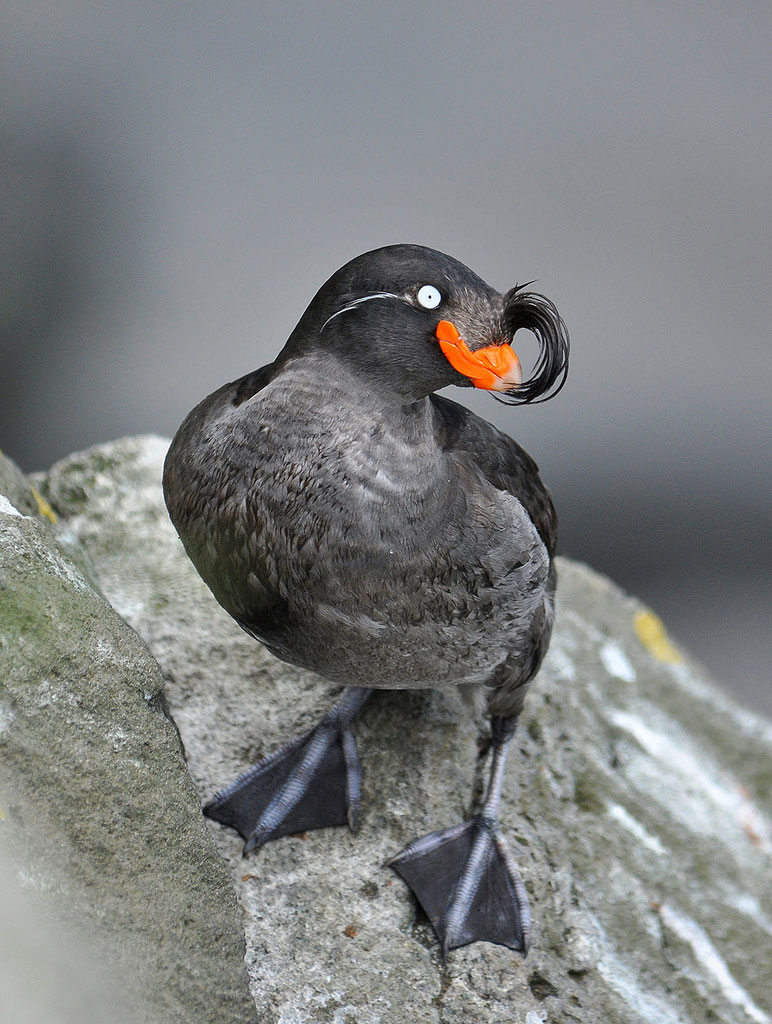
(Photo: © Ryan P. O’Donnell)
[WIND AND WAVES AND CALLS FROM A FLOCK OF CRESTED AUKLETS]
MCCANN: A petite cousin of puffins, the Crested Auklet stands 10 inches high, weighs nine ounces, and is feathered in charcoal gray. This little seabird takes its name from a comical crest curling out over the top of its large, orange bill. If that’s not whimsical enough, Crested Auklets bark like Chihuahuas.
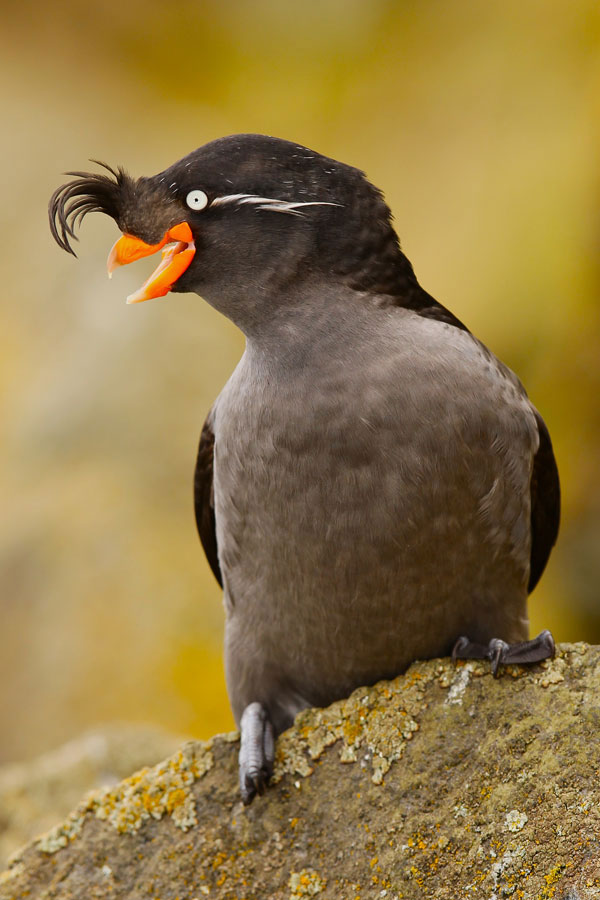
(Photo: © Paul Jones)
[SOUNDS OF CRESTED AUKLETS BARKING CALLS]
MCCANN: And to top that off, the seabirds exude an odor of oranges from a chemical they produce that repels bothersome ticks. Crested Auklets nest in immense colonies on Bering Sea islands, and remain nearby through winter, in flocks of many thousands.
[SOUNDS OF CRESTED AUKLETS BARKING CALLS]
MCCANN: Because the auklets concentrate in huge numbers, they’re at risk from oil spills. The auklets present a superb natural spectacle. Picture a flock of tens of thousands of Crested Auklets flying low across the wave tops, yipping like an army of Chihuahuas... while trailing a perfume of fresh citrus.
[SOUNDS OF CRESTED AUKLETS BARKING CALLS]
MCCANN: I’m Mary McCann
CURWOOD: For some photos of Crested Auklets fly on over to our website, loe dot org. Take a look - what a hairdo!
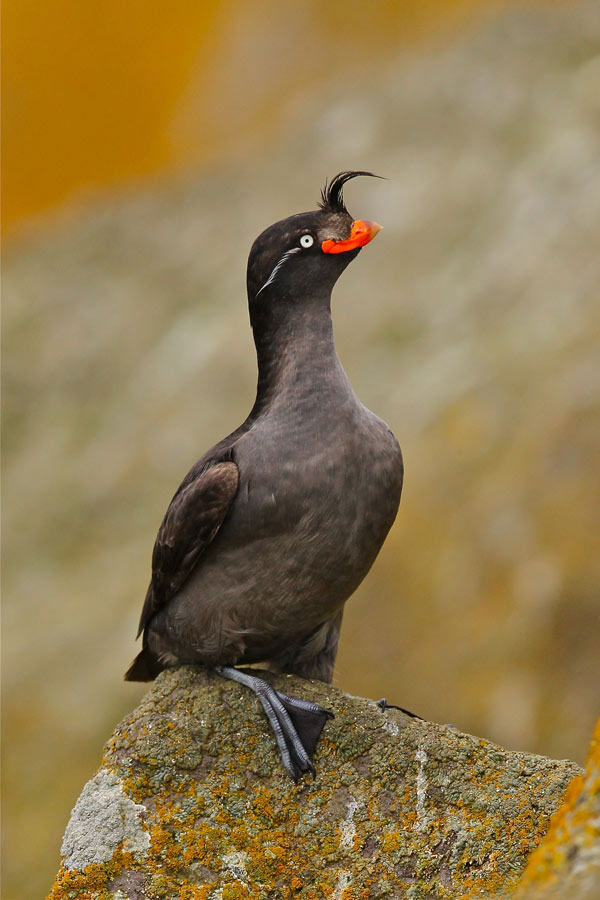
(Photo: © Paul Jones)
Written by Bob Sundstrom
Bird sounds provided by The Macaulay Library of Natural Sounds at the Cornell Lab of Ornithology, Ithaca, New York. Calls of Crested Auklets [132013] recorded by S. Seneviratne.
Producer: John Kessler
Executive Producer: Chris Peterson
© 2012 Tune In to Nature.org December 2012 Narrator: Mary McCann
Reference on orange odor/aldehyde: http://aba.org/birding/v37n4p424.pdf
Related link:
BirdNote
[MUSIC: Global Noize “In The Air” from A Prayer For The Planet (GNT Productions 2011).]
CURWOOD: Coming up – new research on some measures taken to fight the crude in the Gulf after the BP oil well explosion suggests the cure may have been a disaster as well. Keep listening to Living on Earth!
ANNOUNCER: Funding for Living on Earth comes from the Grantham Foundation for the protection of the environment. Supporting strategic communications and collaboration in solving the world’s most pressing environmental problems. The Gordon and Betty Moore Foundation. The Kendida Fund, furthering the values that contribute to a healthy planet. And Gilman Ordway for coverage of conservation and environmental change.
This is PRI, Public Radio International.
[CUTAWAY MUSIC: Dave Brubeck: Three To Get Ready” from Time Signatures: A Career Retrospective (Columbia Records 1992).]
Oil Dispersants and the Ecology of the Gulf

Gulf oil spill on the beach (photo: bigstockphoto.com)
CURWOOD: It's Living On Earth, I'm Steve Curwood. In April 2010, when the Deepwater Horizon disaster ravaged the Gulf of Mexico, BP decided to use a chemical called Corexit to try to disperse the gushing oil. The use of dispersants was controversial at the time, and now scientists have released the results of laboratory experiments designed to assess what effects that dispersant - oil mix may have had on the Gulf of Mexico. The experiments used marine plankton called rotifers. Dr. Terry Snell, chair of the School of Biology at Georgia Tech was one of the researchers.
SNELL: Rotifers are animals, they're microscopic but they have all of the complex systems that any other animals have. They're useful in ecotoxicology because we can expose these animals to a variety of toxicants, and we can kill them by the millions without anybody caring very much.
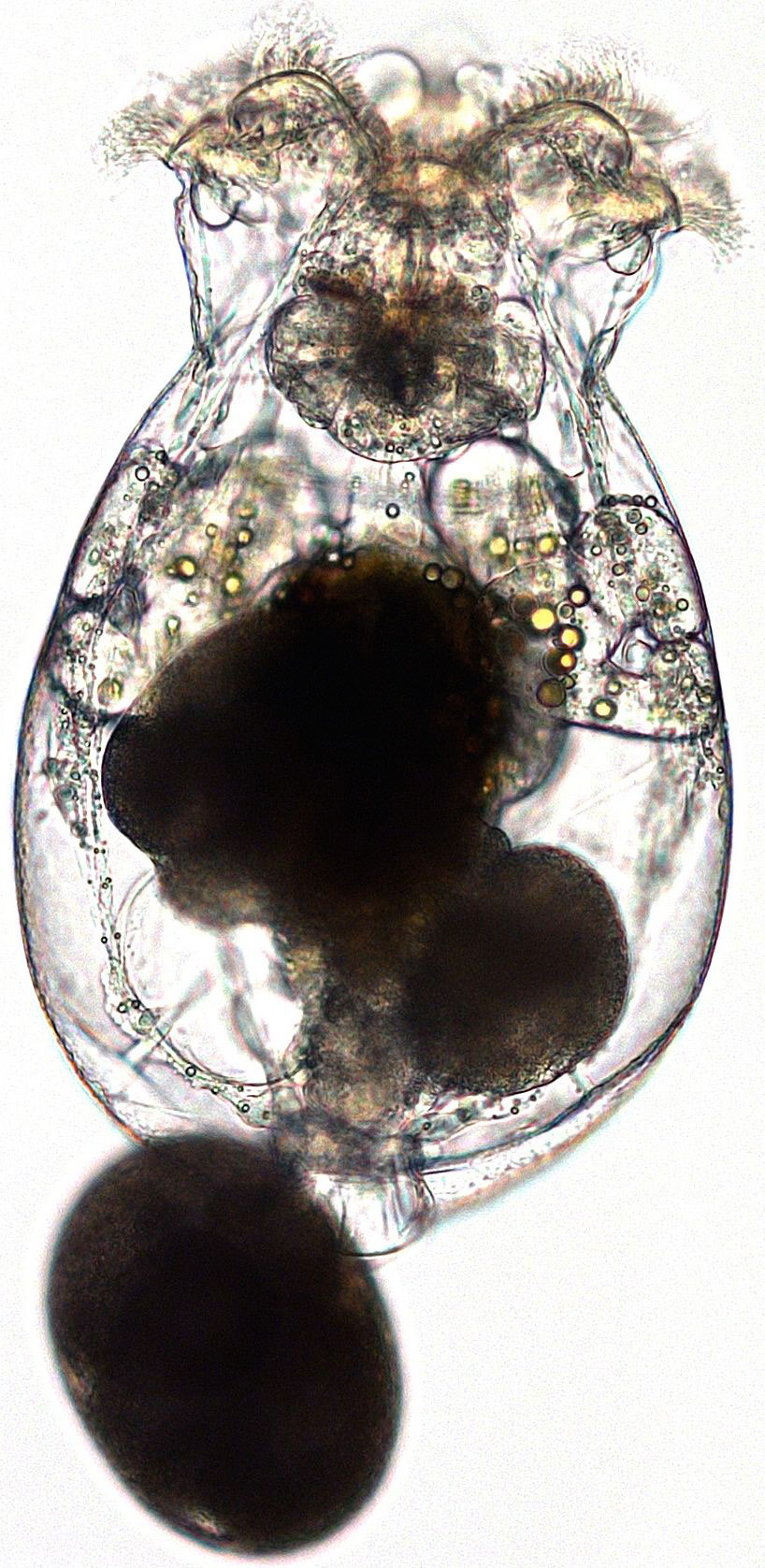
A female rotifer (photo: Terry Snell)
CURWOOD: Well, now the study findings have been published in the journal Environmental Pollution, with Terry Snell as one of the lead authors.
SNELL: We were interested in what the consequences might be of using this dispersant Corexit in treating the oil spill from the Macondo oil well head. And we had a suspicion that there might be some synergistic effects in terms of the toxicity of the oil and the Corexit that may not have been observed or recorded previously. We tested whether when you mix the oil and the Corexit together, you get a larger toxicity than you would have with either the oil or the Corexit by itself.
CURWOOD: And, what were your results?
SNELL: In fact, we saw significant synergies between the oil and the Corexit. As much as 52 times greater toxicity when we applied the mixture in the test versus when we applied either the oil or the Corexit by itself. In toxicology, we are measuring something called a LP50, or the concentration it takes to kill 50 percent of the test organisms in the test period, in this case 24 hours. So, when we say it’s about 52 times more toxic, that means that the concentration that it takes to kill 50 percent of the organisms in 24 hours is 52 times lower than the original concentration.
CURWOOD: And the point here is that the rotifers are a marker for the entire ecosystem? That as a biologist you would be concerned about all of the organisms there in the ocean?
SNELL: Yeah, so the rotifers are what we would call a model organism. A biomarker representing the planktonic ecosystem. We tested this component of the planktonic ecosystem – that is rotifers – to get a guage for whether this component of the ecosystem was harmed. And, in fact, it was. Now, we leave it to other people to test fish and crabs and other components of the marine ecosystem, but rotifers are the base of the food chain. That is, they are filter feeders who eat the algae, and they are in turn making that energy available to higher tropic levels like larval fish. So, the larval fish themselves cannot eat the algae, they have to eat something that is capable of consuming the algae, the algae is the base of all the food chain.
CURWOOD: What were scientists saying about dispersants back in 2010 when the Deepwater Horizon oil spill occurred?
SNELL: I think the concern back then was that we didn’t know enough to use these kinds of chemicals on such a broad scale, and that the basic research that should have been done before the disaster was not done and the information simply wasn’t there.
CURWOOD: Now, why do you suppose that BP used this dispersant against the advice, against the concerns, of a number of biologists?
SNELL: I think that BP used the dispersant at the direction of the Environmental Protection Agency. I mean obviously they were very concerned about the oil rolling up onto the shores and into the marshes. What the dispersants do quite effectively is to make the oil disappear because it goes from big globs into very small, hard to see droplets. So, in the decision to keep the oil off the beaches, they kind of roll the dice biologically and hope that there wasn’t any major impacts in the marine ecosystems. And it turns out, at least in this planktonic ecosystem, there were substantial impacts.
CURWOOD: You don’t have the hard data, but in the end, what do you suspect the ecological effect of this massive use of dispersants was on the Gulf?
SNELL: The Gulf, of course, is a huge, massive, complex ecosystem, so it’s hard to say exactly what the effects will be. I mean, what we focused on was a small component of that system, and what we can tell you is that there were two main effects. One is a suppression of rotifer abundance and biomass in the water column. That suppression probably didn't last more than a few months. The second maybe more worrisome effects is that there is toxicity in the benthic community to the dormant eggs that these rotifers produce.
CURWOOD: Benthic is the bottom, of course.
SNELL: The bottom. So these eggs that are lying in the sediments on the bottom are the things that will recolonize the water column in the spring and allow the population to regrow. Not only do rotifers produce these dormant eggs, but also algae and also dinoflagellates, and copepods produce these. So, the whole planktic community is reconstituted every spring from those dormant eggs in the sediment.
If those dormant eggs in the sediment don’t hatch because of the toxic effects of the oil and the dispersant, then there is going to be less biomass available for the small animals that feed on these plankton, namely larval fish, larval crabs and larval shrimp. So, we expect to see those populations also suppressed, and this may happen over a span of several years.
CURWOOD: So, the Gulf of Mexico is a pretty tough place now for marine creatures to operate. We’ve had of course these dead zones that don’t have oxygen. We’ve had this massive oil spill, now dispersants have been added there. Overall, what concerns do you have about the health of the Gulf as an ecosystem?
SNELL: Well my concern is that these stressors are cumulative. And you can take any one of those stressors maybe by itself but it takes years to recover from a stressor of the magnitude that we saw from the oil spill. And then when you add each stressor onto the load of stressors that the organisms are Bering, and you put in things like climate change, global warming, ocean acidification… these things are presenting more and more challenges to the animals and plants that live in the Gulf.
And my worry is that at some point these challenges may be so great that we may come to a tipping point, when the populations might in fact crash as a result of these cumulative effects.
CURWOOD: Terry Snell is Chair of the School of Biology at the Georgia Institute of Technology, thank you so much!
SNELL: You’re welcome.
CURWOOD: We contacted Nalco, the makers of the dispersant Corexit; they declined to comment on the study.
Related links:
- Study on dispersants and oil published in Environmental Pollution
- More about Prof. Terry Snell, chair, School of Biology at Georgia Tech
- US Environmental Protection Agency’s directives regarding the use of dispersants during the BP Macondo oil well spill disaster
[MUSIC: Dave Brubeck “Unsquare Waltz” from Time Out (Columbia Records 1959).]
Predicting the End of the World
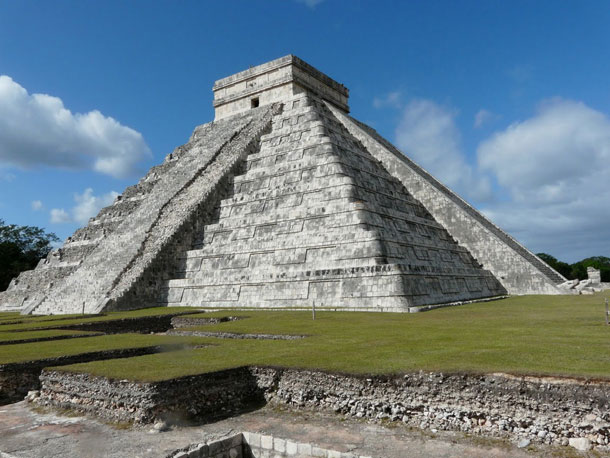
The Castillo Pyramid at Chichen Itza (Photo: Bruce Gellerman)
CURWOOD: It's approaching the end of the year - a time when many of us look back - and look forward. But predicting what's going to happen in the future has often included predictions that there may not be much future - indeed, since the beginning of recorded time there have been predictions of the end of time. And as Living on Earth's Bruce Gellerman reported, that happened in May last year.
TAPE: On May 21.2011 …the date of the rapture…each and every saved person goes to heaven…. How can anyone dare to dispute the bible that the absolute truth that the beginning of the day of judgment together with the rapture will occur May 21, 2011.
GELLERMAN: Of course, in the end, the end didn’t occur; the apocalypse was delayed due to matters of biblical interpretation and math errors.
[VIDEO SFX]
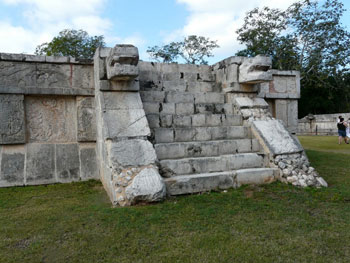
Detail of Maya ruins at Chichen Itza. (Photo: Bruce Gellerman)
GELLERMAN: But wait! The end is near – again. The internet is filled with fire and brimstone videos and books prophesying the approaching apocalypse, based upon the exquisitely precise astronomical calculations of the Ancient Maya:
VIDEO: According to the Maya calendar this cycle of creation will cease to exist at precisely at 4 ahoo, 3 kencan; Sunday December 23 2012.
[CRASHING SOUNDS]
GELLERMAN: According to this new age interpretation of ancient Maya time telling, Doomsday is just around the corner.
VIDEO: Will you be ready?
GELLERMAN: Well, it depends. Seems there’s some dispute even among Maya end-of the world watchers. Doomsday could either be December 23rd, 2012, when a cosmic collision with Planet X Nibiru destroys earth - or our demise could come on Dec. 21st at exactly 11:11 universal time. That’s the winter solstice and, for the first time in 25,765 years, the sun will align with the center of the Milky Way.
[SOUNDS OF WALKING ON GRAVEL AND WIND]
GELLERMAN: But before abandoning all hope and earthly possessions I decided to find out what’s behind the Maya Doomsday prophecy. So I traveled to the Maya ruins of Chichen Itza, on Mexico’s Yucatan peninsula.

Archeologist Bill Saturno. (Photo: Cenzo Saturno)
VENTURA: I love Chichen Itza, I like Chichen Itza a lot. That’s why I like to share with people my history, my culture.
[WIND SOUNDS]
GELLERMAN: On a warm, windy day, I met veteran Chichen Itza guide Jorge Marina Ventura, at the magnificent, thirteen hundred year old ruins.
VENTURA: Chichen Itza was a religious capital for the Mayas. It was one of the most important cities of the whole Mayan territory of the pre-Hispanic time.
GELLERMAN: By the time Spanish conquistadors arrived at Chichen Itza in 1526 the city had been abandoned for nearly 500 years. The collapse of the Maya Civilization at Chichen Itza, and the disappearance of their ancestors who lived centuries before in the lowlands of Central America, comprise one of the great archeological mysteries of our time. Scientists have searched these ruins high and low looking for answers. So did I:
Whoa, look at this….
VENTURA: This is the pyramid of Kukulkan or Quetzalcoatl, and both words mean the feathered serpent.
[ECHOING CLAPPING SOUNDS]
GELLERMAN: The pyramid at Chichen Itza towers over the landscape. Sound echoes as tour guides clap to demonstrate the extraordinary acoustics of this sacred place. At the equinox, a shadow of the feathered serpent can be seen slithering down one of the 4 staircases.
Each has exactly 91 steps. Added together with the top platform, that equals 365, the days in a solar year. The Maya had only stone tools and lacked the wheel, yet they were master mathematicians, architects and astronomers.
VENTURA: What happened is the pyramid, it was working as a calendar, and at the same time was an astronomical observatory.
GELLERMAN: Was it accurate?
VENTURA: Oh yeah, definitely yes. Mayan calendar, I dare say it was the most accurate calendar that a human being ever had. Right after the Maya, the next one is our calendar, the Gregorian calendar. So these people had a great knowledge of astronomy.
GELLERMAN: The Maya had not one calendar, but three – the solar calendar, a religious calendar of 260 days, and the Long Count: precisely 1,872,000 days, or 5,125.36 years, starting from the time the Maya believed the world began. The Long Count ends - in December 2012.
VENTURA: 2012 the Maya prophecy says the world as we know it is going to change. What is going to be ending is going to be a term of time of 5,125 years, and we are part of that. But we don’t know what’s going to happen 2012!
GELLERMAN: Well, I searched for, and found, an expert who really should know.
SATURNO: I’m William Saturno. I’m an archeologist at Boston University, my specialty is the ancient Maya.
GELLERMAN: Is the world going to end on December 21, 2012?
SATURNO: I wouldn’t bet on it. That’s unlikely. I mean, I guess it’s as likely to end on that date as any date before it or after it, in reality.
GELLERMAN: Professor Saturno says time is relative. It’s all a matter of which calendar you use.
SATURNO: Now there may be different calendars, you might be in year 5264. The Jewish calendar uses different numbers. The Chinese calendar uses different numbers. But all of them represent a count since we started counting. And the Maya Long Count is just that. Now the Maya Long Count is sort of interesting to us because it works sort of like an odometer in your car.
Now, just as in a car you used to only have enough digits in an odometer for 100,000 miles, although that marks a great passing, most of us are pretty sure that our car isn’t going to vanish in 100,000 miles; that a car doesn’t in fact come to an end. Right? That, “Oh my God, I’m approaching 100,000 miles, it’s going to explode, it’ll disappear, I’ll be in it, what if my kids are in it?” We don’t bother ourselves with that. We know that even if all of the zeros go back to zero, we know that it’s not going to disappear.
GELLERMAN: Actually, scientists believe 65 million years ago much of life on earth did disappear when a giant meteorite struck the northern Yucatan coast, not far from Chichen Itza. Jorge, my guide, says the cataclysmic impact also helped create the cenotes, or underground limestone sinkholes, that today store most of the water on the arid peninsula.
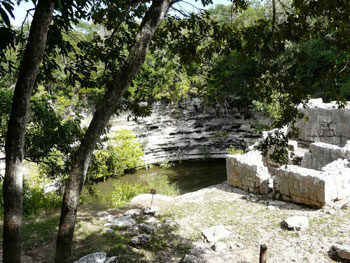
A cenote water hole. (Photo: Bruce Gellerman)
[WIND SOUNDS]
VENTURA: This is the sacred cenote. They believed that the rain god was living at this cenote. Actually at the Chichen Itza area, there are about eight of them. Eight!
GELLERMAN: In this dry place with no above ground rivers or sizeable lakes, the water filled sinkholes were life sustaining. And some were sacrificial sites, as archeologists discovered when they drained the sacred cenote.
VENTURA: In this one the archeologist took out 251 human skeletons so far. They were sacrifices, sir. They would jump alive into the sinkhole.
GELLERMAN: An offering to the god ---?
VENTURA: An offering to the god, to the rain god Yun Chaac that they thought was living in this sinkhole here.
GELLERMAN: Apparently, the sacrifices weren’t sufficient. The rain god didn’t deliver. Around the 9th century, the Yucatan suffered a severe drought, made worse by deforestation. The Maya had cut down the forest, clearing the land to grow crops for their cities.
VENTURA: You know the drought would bring a lot of problems like no food, and fights, you know, invasions, and at the end of the season the people went away looking for a better place to live.
SATURNO: The people don’t die and vanish.
GELLERMAN: BU archeologist William Saturno:
SATURNO: When we talk about the collapse of Maya what they’re really talking about is the collapse of government. There’s evidence for drought, you know, a few drought years would lead to big problems on a social level. Is it the cause? Well, it’s not the drought that causes the collapse. It’s the human response that causes collapse.
GELLERMAN: So what is the lesson, if any, that we can learn from the Maya?
SATURNO: The lesson is a very poignant one. The lesson is really that we need to be more flexible, that we need to have the flexibility that enables us to see the writing on the wall and then react to it. Because if we can’t react, all the lessons we can learn are simply lessons for the next generation - the generation that rebuilds after collapse.
[MUSIC: Jose Luis Monton “Conclusion” from Solo Guitarra (ECM Records 2012).]
GELLERMAN: Boston University Archeologist William Saturno ending that report by Living on Earth’s Bruce Gellerman. And as the Maya Long Count completes its cycle, a reminder that all things come to an end, and navigating the time left for our civilization is in our hands.
Related link:
Learn More at NOVA’s Maya Site
[MUSIC CONTINUES]
CURWOOD: Living on Earth is produced by the World Media Foundation. Bobby Bascomb, Emmett Fitzgerald , Helen Palmer, Annie Sneed, James Curwood, Meghan Miner, and Gabriela Romanow all help to make our show. Jeff Turton is our technical director. Alison Lirish Dean composed our themes. You can find us anytime at L-O-E dot org - and check out our Facebook page - it’s PRI’s Living on Earth. I'm Steve Curwood. Thanks for listening!
ANNOUNCER: Funding for Living on Earth comes from Stonyfield Farm, makers of organic yogurt, smoothies, and more. Stonyfield invites you to just eat organic for a day. Details at just eat organic dot com. Support also comes from you, our listeners. The Go Forward Fund and Pax World Mutual and Exchange Traded Funds, integrating environmental, social, and governance factors into investment analysis and decision making. On the web at Pax World dot com. Pax World, for tomorrow.
ANNOUNCER 2: PRI, Public Radio International
Living on Earth wants to hear from you!
Living on Earth
62 Calef Highway, Suite 212
Lee, NH 03861
Telephone: 617-287-4121
E-mail: comments@loe.org
Newsletter [Click here]
Donate to Living on Earth!
Living on Earth is an independent media program and relies entirely on contributions from listeners and institutions supporting public service. Please donate now to preserve an independent environmental voice.
NewsletterLiving on Earth offers a weekly delivery of the show's rundown to your mailbox. Sign up for our newsletter today!
 Sailors For The Sea: Be the change you want to sea.
Sailors For The Sea: Be the change you want to sea.
 The Grantham Foundation for the Protection of the Environment: Committed to protecting and improving the health of the global environment.
The Grantham Foundation for the Protection of the Environment: Committed to protecting and improving the health of the global environment.
 Contribute to Living on Earth and receive, as our gift to you, an archival print of one of Mark Seth Lender's extraordinary wildlife photographs. Follow the link to see Mark's current collection of photographs.
Contribute to Living on Earth and receive, as our gift to you, an archival print of one of Mark Seth Lender's extraordinary wildlife photographs. Follow the link to see Mark's current collection of photographs.
 Buy a signed copy of Mark Seth Lender's book Smeagull the Seagull & support Living on Earth
Buy a signed copy of Mark Seth Lender's book Smeagull the Seagull & support Living on Earth

